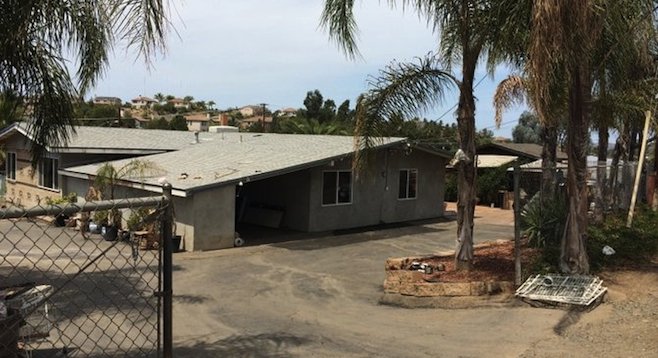 Facebook
Facebook
 X
X
 Instagram
Instagram
 TikTok
TikTok
 Youtube
Youtube

Elias Cardenas says he had big plans for the small plot of land that he inherited from his father. In one corner he sells birds. On the other side of the house he's constructing a small fish farm next to a nursery that he rents out to another business owner. But he recently learned that in a couple of years, none of it may exist.
As part of its capital-improvement plan, the Oceanside City Council approved $1.17 million for the final engineering of a 3000-foot connector between two sections of Melrose Drive. The new road would improve traffic flow to a neighborhood while sacrificing farmland, part of Guajome Regional Park, and Elias's home.
“[Not having this home] is hard to think about, when it's something that you've had for a long time,” Elias said. “They've taken land twice to widen Santa Fe Avenue. I can remember when it was one lane and a dirt road.”
His family has received letters for years, but after a while they assumed it was never going to happen.
The Melrose Drive extension has been batted around Oceanside since 1991. In 2002, the city began drafting an environmental impact report. In 2005, a more liberal majority defunded the project and halted plans. After the 2006 election, the developer-friendly majority reinstated it.
“This project does not serve the community,” deputy mayor Esther Sanchez said. “It is only to increase development in our agricultural lands.”
A lawsuit brought by Preserve Calavera, which fights development in Carlsbad and Oceanside, was successful at having the road reduced from six lanes to a four-lane highway. Despite the decreased width, Oceanside will most likely ask Elias to sell his whole property.
Elias's only alternative is to resist selling and force an eminent-domain vote in city council. But funding remains one challenge in the cash-strapped city. Another is that the council doesn't have the four-fifths majority required to vote on eminent domain, for at least two years. And councilmember Jerry Kern, who ran in 2006 on a commitment to complete the project, is up for reelection this year.
While Oceanside sorts out its politics, Elias and others who live and work in the area have little voice in the matter. They live on unincorporated land, and the county has already given Oceanside the green light.
Earlier this year, Elias drove around a few neighborhoods with his three daughters, exploring the idea of investing in a home in Oceanside. “They thought we were moving and were crying, ‘We don't want to leave!'” Elias said.


Elias Cardenas says he had big plans for the small plot of land that he inherited from his father. In one corner he sells birds. On the other side of the house he's constructing a small fish farm next to a nursery that he rents out to another business owner. But he recently learned that in a couple of years, none of it may exist.
As part of its capital-improvement plan, the Oceanside City Council approved $1.17 million for the final engineering of a 3000-foot connector between two sections of Melrose Drive. The new road would improve traffic flow to a neighborhood while sacrificing farmland, part of Guajome Regional Park, and Elias's home.
“[Not having this home] is hard to think about, when it's something that you've had for a long time,” Elias said. “They've taken land twice to widen Santa Fe Avenue. I can remember when it was one lane and a dirt road.”
His family has received letters for years, but after a while they assumed it was never going to happen.
The Melrose Drive extension has been batted around Oceanside since 1991. In 2002, the city began drafting an environmental impact report. In 2005, a more liberal majority defunded the project and halted plans. After the 2006 election, the developer-friendly majority reinstated it.
“This project does not serve the community,” deputy mayor Esther Sanchez said. “It is only to increase development in our agricultural lands.”
A lawsuit brought by Preserve Calavera, which fights development in Carlsbad and Oceanside, was successful at having the road reduced from six lanes to a four-lane highway. Despite the decreased width, Oceanside will most likely ask Elias to sell his whole property.
Elias's only alternative is to resist selling and force an eminent-domain vote in city council. But funding remains one challenge in the cash-strapped city. Another is that the council doesn't have the four-fifths majority required to vote on eminent domain, for at least two years. And councilmember Jerry Kern, who ran in 2006 on a commitment to complete the project, is up for reelection this year.
While Oceanside sorts out its politics, Elias and others who live and work in the area have little voice in the matter. They live on unincorporated land, and the county has already given Oceanside the green light.
Earlier this year, Elias drove around a few neighborhoods with his three daughters, exploring the idea of investing in a home in Oceanside. “They thought we were moving and were crying, ‘We don't want to leave!'” Elias said.
Comments